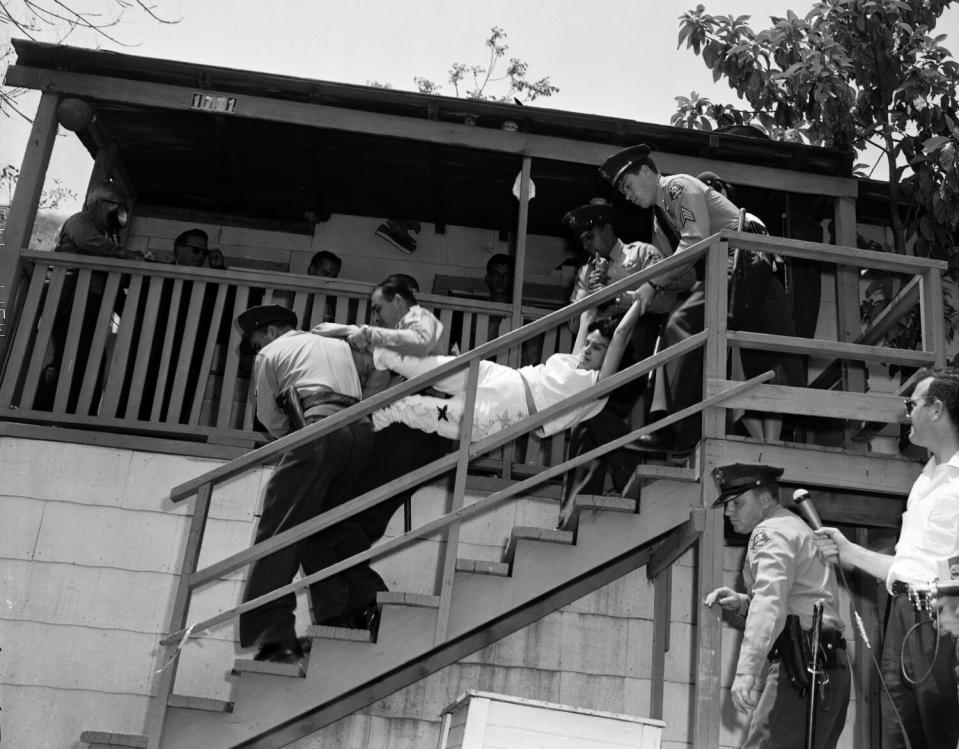Tyrone Beason
Few governmental practices have caused more rapid disruption or erosion of generational wealth in Black and brown communities than the discriminatory use of eminent domain — the legal tool cities, counties and other official bodies rely on to unilaterally condemn and purchase private land for public use.
Several reparations bills moving through the state Legislature could help Californians of color who believe their land was taken against their will with racist intent to finally get restitution.
The bills turn the spotlight on a phenomenon that is woven into the Golden State’s history, said California state Sen. Steven Bradford
Get info without
leaving the page., a Democrat from Gardena who authored three of the pending bills.
Under pressure from the Ku Klux Klan, the city of Manhattan Beach used its eminent domain authority in 1924 to drive out a seaside resort for Black guests owned by Willa and Charles Bruce, promising to put a park in its place.
Just as Silas White was about to realize his dream of establishing the Ebony Beach Club as a Black-owned haven free of racism in 1958, Santa Monica used eminent domain to confiscate his property, demolishing it with plans to create public parking. The luxury Viceroy Hotel now sits on the lot.
“There are multiple examples of African American families who were forced off their land, for no other reason than they didn’t want them there anymore,” Bradford said. “And now their homes have been replaced with freeways or parking lots, or as in Manhattan Beach, an alleged park that was 40 years before it even came into development.”
Read more: History made: Bruce’s Beach has been returned to descendants of Black family
Families that were forced to sell their land for less than it was worth lost out on years of potential gains from their properties, depriving them of the chance to grow and pass down assets to their heirs, Bradford said.
At a recent Senate Judiciary Committee hearing, Bradford sat next to Jessie Johnson as she spoke of a pain that hasn’t abated in the six decades since her grandfather’s land was seized in the largely Black and Latino Bay Area community of Russell City, in what was then unincorporated Alameda County. The land wound up in the hands of a developer and was annexed by the city of Hayward.
“We thought we would have the liberty to build on my grandfather’s land,” Johnson told committee members. “Unfortunately, eminent domain took over.”
Bradford believes that hundreds and perhaps thousands of other California property owners, or their descendants, may seek financial remedies under the proposed law.
“I can’t assign a dollar figure — that’s how big it is,” he said.
Bradford’s reparations legislation would set up the Freedmen Affairs Agency, which, among other things, would determine the validity of claims brought by families that believe their property was unjustly seized.
The legislation currently defines racially motivated eminent domain as “when the state, county, city, city and county, district, or other political subdivision of the state acquires private property for public use and does not distribute just compensation to the owner at the time of the taking, and the taking, or the failure to provide just compensation, was due, in whole or in part, to the owners’ ethnicity or race.”
The state’s Office of Legal Affairs would be tasked with presenting the offending entities with possible remedies, such as the return of the seized lands, publicly owned land of equal present-day value or monetary payments.
Bradford’s bills stem from his participation on the state reparations task force, which spent two years studying how California permitted the enslavement of Africans arriving in the state without formally sanctioning the institution of slavery itself. It also examined public policies, such as the use of eminent domain, that further disadvantaged Black Californians.
The senator said he expects the eminent domain provision, which is part of a package of reparations proposals recommended by the task force and backed by the California Legislative Black Caucus, to reach Gov. Gavin Newsom’s desk by the end of the current legislative session.
Racially biased eminent domain isn’t a problem only in California. One study authored by research psychiatrist Dr. Mindy Thompson Fullilove and published by the nonprofit Institute for Justice looked at cases involving the Federal Housing Act between 1949 and 1973. It found that 2,532 civic projects carried out in 992 cities displaced 1 million people, two-thirds of them Black Americans, making that group “five times more likely to be displaced than they should have been given their numbers in the population.”
But although Black Americans have largely been the focus of state and national reparations efforts, Bradford said his eminent domain proposal applies to members of other racial groups as well.
“I hope people understand the importance of reparations by seeing that other folks were harmed too because of the racially motivated taking of their property,” Bradford said.
Read more: People of color lost a haven in Palm Springs. A new play dramatizes their loss
Bradford’s Senate bills coincide with AB 1950, a separate reparations measure introduced by state Assemblywoman Wendy Carrillo (D-Los Angeles) on behalf of families from the former Palo Verde, La Loma and Bishop neighborhoods of Chavez Ravine, where Dodger Stadium stands today, who are seeking restitution for their losses.
In the 1950s, Los Angeles officials evicted families on a 315-acre hillside site that encompassed the largely Latino neighborhoods on the premise that public housing would be built there. Harrowing scenes ensued of children sobbing and a woman kicking and screaming as sheriff’s deputies carried her away by her arms and legs.
“The shorthand version of the story is that the homes in these communities were deemed as ‘slums’ by the Los Angeles Housing Authority, so the compensation provided to the families was lower than what the land should have been priced at,” said Carrillo. “For those that refused to leave, eminent domain was used to remove them.”
Carrillo represents parts of northeast and East L.A., home to large Latino communities. In an email, she explained how racist land grabs and redevelopment schemes have disrupted the lives of Angelenos of color.

“Restrictive covenants, redlining and segregation by design has always been the housing story of Los Angeles,” said Carrillo, who also noted that the expansion of the 10 Freeway toward Santa Monica destroyed the affluent Black Sugar Hill neighborhood in West Adams.
For Chavez Ravine families, restitution could come in the form of land, cash payments or access to city programs such as affordable-housing assistance, said Alfred Fraijo, an L.A. real estate and land-use attorney who served as an advisor on the legislation.
“The idea is we want to give local government the opportunity to do right,” before cases devolve into protracted courtroom and media spectacles, Fraijo said.
He believes Carrillo’s Chavez Ravine Accountability Act, along with Bradford’s bill, could, if successful, prompt government entities to more strongly consider racial and economic equity when considering future uses of eminent domain.
Fraijo, 47, grew up in the heavily Latino East L.A. neighborhood of Boyle Heights and remembers feeling hemmed in by a tangle of interchanges connecting the 10 and 5 freeways, whose construction had erased streets lined with Victorian and Craftsman-style homes.
“These freeways were not built in our community by accident — they were intentional,” Fraijo said.
He describes AB 1950 as “the beginning of a reconciliation and a healing process for our communities.”
Read more: A California tribe was twice robbed of its land. A 77-acre purchase brings hope
The restitution bills come as welcome news to activist Kavon Ward too. Ward started the organization Where Is My Land to help Black Americans in California and nationwide fight for their stolen properties.
Her organization has advised families in the Ebony Beach Club, Russell City and Bruce’s Beach cases, as well as survivors of Section 14 in Palm Springs who were evicted from their homes on the Agua Caliente tribal reservation in the 1960s.
Ward and Bradford’s work on Bruce’s Beach helped the family reach a deal in which Los Angeles County returned two parcels to the family, marking the first time that a local government had given back land to a Black family after recognizing that it had been unfairly seized. The family subsequently sold the property back to the county for nearly $20 million.
Ward consulted with Bradford on his land bill to eliminate the standard five-year statute of limitations on eminent domain challenges, because many of the unfair land takings happened decades ago.
“There should be no statute of limitations on stolen land like this,” Ward said. “The policy is extremely important, because it helps everybody.”
Ward said she understands the fraught politics of the Black land return movement, given the current backlash against government equity and inclusion efforts, attacks on Black history education and repeated attempts to enact a national reparations bill into law.
Some Indigenous leaders have sought a greater role in the state reparations debate. Tribal nations, the original stewards of all of California’s lands, are pushing for the return or co-management of their stolen ancestral territories.
Ward said that land-based restitution cases for Black Americans should not be seen as conflicting with the tribal land reclamation.
“When I think about the LandBack movement, I love that movement,” Ward said. “They’re focused on Native land and they should. What I realized with Bruce’s Beach is that this is so widespread, but nobody is focusing on Black people.”
Bradford agrees that it won’t always be easy to persuade local elected officials to spend taxpayers dollars to set up their own task forces, study the potential return of publicly owned parcels, issue payouts for past land seizures and invest in other reparative measures.
Nothing in either Bradford’s legislation or Carrillo’s obligates eminent domain offenders to make families whole, nor do they commit the state to offering compensation for unjustly seized properties with tax dollars instead, Bradford and Fraijo said.
In the case of Chavez Ravine, Carrillo’s bill has come under criticism from survivors in the nonprofit advocacy group Buried Under the Blue, who recently told radio station KCRW that many members are withholding support for Carrillo’s bill until it holds the Dodgers organization more accountable.
The organization has not responded to a request for comment about the bill.
Bradford said he is confident that despite the potential obstacles, more families will have an easier pathway to restitution.
But he acknowledged that “all cases are not going to end successfully like Bruce’s Beach.”
This story originally appeared in Los Angeles Times.




